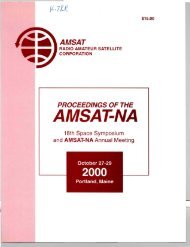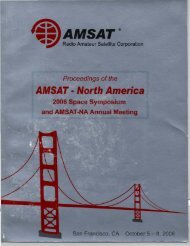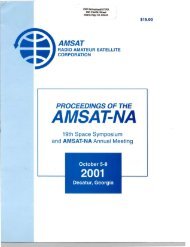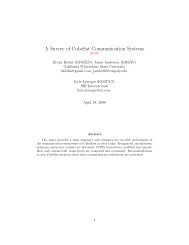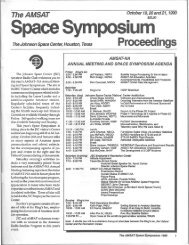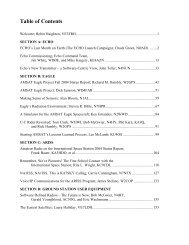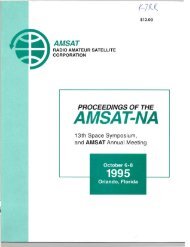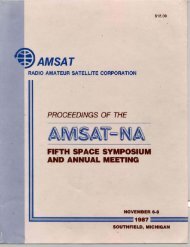November 8-10, 1991 - Klofas.com
November 8-10, 1991 - Klofas.com
November 8-10, 1991 - Klofas.com
Create successful ePaper yourself
Turn your PDF publications into a flip-book with our unique Google optimized e-Paper software.
Impact Sensor<br />
The impact sensor was designed and built by students at<br />
Brighton High School in Sandy, Utah, with assistance from the Zevex<br />
corporation of Murray, Utah. It can detect small vibrations caused<br />
by micro-meteor impacts, opening and closing of the camera iris,<br />
and thermal stress.<br />
The detector is a 6 x 1.25 inch piezoelectric strain gauge,<br />
mounted on the +X surface of the satellite. When acceleration of<br />
the sensor occurs, voltage pulses are generated and summed. The<br />
resulting voltage is sampled by an analog to digital converter, and<br />
translated into a digital value ranging from 0 to 255 (0 to FFh).<br />
This value is reported in the telemetry data.<br />
A second, identical sensor is mounted inside the attic module,<br />
perpendicular to the external sensor. This detector feeds the<br />
count circuit in such a way as to inhibit a count from being<br />
recorded if the whole frame flexes, as it might during a thermal<br />
event. strikes of moderate intensity may cause a portion of the<br />
structure to ring (produce a damped oscillation). This results in<br />
a greater pulse count if the impact was not large enough to trigger<br />
the second sensor.<br />
This configuration does not provide quantity or magnitude data<br />
directly, but when sample period, rate of change, and environment<br />
factors are accounted for, inferences about relative magnitude or<br />
quantity can be made.<br />
Impact Detection<br />
The impact sensor has been recording events that would<br />
indicate impacts from micrometeorites and dust. Thermal expansion<br />
stress has also been occasionally observed. Whole Orbit Data (WOO)<br />
collection of the impact sensor was taken during several of the<br />
large meteor showers such as the persads meteor showers to see if<br />
the impacts increase during these events. used during The value<br />
given for an impact is between 0 and 256, depending on the<br />
magnitude of the hit. A magnitude of <strong>10</strong> is considered a minimum<br />
reading for an impact. If an impact magnitude is greater than 256,<br />
the reading may not be usable because the value will go past 256<br />
and start from zero again. Iris movement in the camera also has<br />
been verified with corresponding impact readings at the time of the<br />
movement. Electrical noise and voltage fluctuations have been<br />
observed to cause a small change in the impact count. These<br />
effects are filtered out by <strong>com</strong>paring changes in 5 and <strong>10</strong> volt bus<br />
values to the variations in impact count.<br />
32



